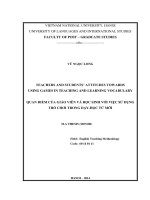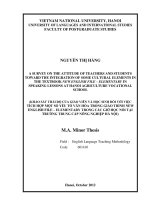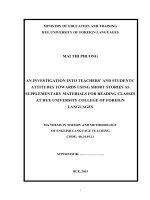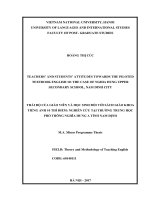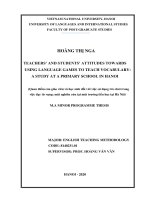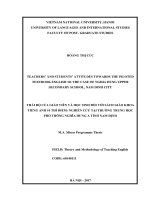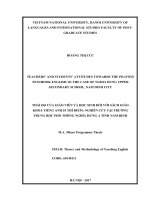teachers’ and students’ attitudes towards using of authentic reading materials in eit at binh thuan vocational college
Bạn đang xem bản rút gọn của tài liệu. Xem và tải ngay bản đầy đủ của tài liệu tại đây (1.68 MB, 124 trang )
STATEMENT OF AUTHORSHIP
I, Tran Van Ty, certify that this thesis entitled, “Teachers’ and students’
attitudes towards using of authentic reading materials in EIT at Binh Thuan
Vocational College”, is my own work.
Except where reference is made in the text of the study, this thesis comprises material
published everywhere or extracted either in whole or in part from a thesis by which I
have qualified for or been awarded another diploma or degree.
No other person’s work has been utilized without due acknowledgments in the main text
of the thesis.
This thesis has not been submitted for the award of any degree or diploma in any other
tertiary institution.
Ho Chi Minh City, 2018
MR. TRAN VAN TY
i
ACKNOWLEDGEMENTS
I cannot express enough gratitude to my supervisor, Dr. Le Hoang Dung,
Dean of the Faculty of English Linguistics and Literature, for his mindful
supervision.
My completion of the study would not have been occurred without my
support of my family and colleagues, who gave me great help in sharing my own
household chores as well as at work during the study.
Also, I am grateful to all my TESOL9 classmates, who were always beside
me and helped me out of difficulties.
Last but not least, my special thanks for my wife, Khue Khuc Khanh Van. I
would not have been able to go beyond in accomplishing the thesis without her
high sympathy and understanding.
ii
ABSTRACT
The utilization of authentic materials has been regarded as an effective teaching
method through its great contribution to the enhancement of English reading for
Information Technology. Accordingly, the study on authentic materials would like to
examine the teachers and IT students’ attitudes toward using authentic materials in IT
reading class.
To achieve these objectives, relevant literature on background of authentic
materials, reading comprehension and previous studies were reviewed in the theory
chapter to shape the theoretical framework of the study.
The study was carried out at Binh Thuan Vocational College with the participation
of 35 IT students and 5 EFL teachers. Mixed-methods research was employed in this
study, i.e., both quantitative and qualitative data were collected from the questionnaire
and semi-structured interview. As for data analysis, descriptive statistics (e.g., mean,
standard deviation, and frequencies/percentages) were used to analyze quantitative data,
whereas qualitative data were analyzed through content analysis.
The findings showed that both teachers and students had positive attitudes on the
effect of authentic materials in IT reading classroom apropos of suitability, naturalness,
usefulness or exploitability. However, while teachers believed the chosen materials
embraced their readability, their students opposed to that.
From the research findings, it is recommended that the teachers should select the
authentic supplementary materials readable and relevant to their students’ cognitive and
proficiency levels.
iii
TABLE OF CONTENT
Page
STATEMENT OF AUTHORSHIP
i
ACKNOWLEDGEMENT
ii
ABSTRACT
iii
TABLE OF CONTENT
iv
LIST OF TABLES
viii
ABBREVIATIONS
ix
CHAPTER 1: INTRODUCTION
1
1.1. Background of the study
1
1.2. Rationale for the study
3
1.3. Research questions
4
1.4. Significance of the study
4
1.5. Scope of the study
5
1.6. Organization of the study
5
CHAPTER 2: LITERATURE REVIEW
6
2.1. Background on authentic materials
6
2.1.1. Definitions
6
2.1.2. Authenticity of materials
8
2.1.3. The needs to authentic materials in language teaching
10
2.1.4. Challenges in the use of authentic materials
11
2.1.5. Criteria for choosing authentic materials
12
2.1.6. Adaptation of authentic materials
2.2. Understanding of reading
14
16
2.2.1. Definition of reading
16
2.2.2. Reading comprehension and English for Specific Purposes
17
2.3. Teachers’ and students’ attitudes
17
2.3.1. Definition of attitudes
18
iv
2.3.2. Components of attitudes
18
2.3.2.1. Affective attitude dealing with authentic reading materials
2.3.2.2. Behavioral attitude dealing with authentic reading materials
2.3.2.3. Cognitive attitude towards dealing with authentic materials
18
20
20
2.4. Previous studies regarding the use of authentic materials
21
2.5. Research gaps
25
2.6. Conceptual framework of the study
26
2.7. Chapter summary
27
CHAPTER 3: METHODOLOGY
28
3.1. Research method
29
3.2. Research site
29
3.2.2 Participants for the research
29
3.2.2.1. Students
29
3.2.2.2. Teachers
30
3.3. Description for reading syllabus in the currently used material
31
3.4. Research tools
33
3.4.1. Student Questionnaire
34
3.4.1.1. Rationale for employing questionnaire
34
3.4.1.2. Description of the student questionnaire
34
3.4.2. Interview
36
3.4.2.1. Rationale for interview
36
3.4.2.2. Description of the student and teacher interviews
36
3.5. Data collection process
37
3.5.1. Administering the questionnaires
37
3.5.2. Conducting teacher and student interviews
38
3.6. Analytical framework
39
3.6.1. Quantitative analysis for questionnaires
39
3.6.2. Qualitative analysis for interviews
39
v
3.7. Reliability and validity
39
3.7.1. Reliability and validity of questionnaire
40
3.7.1. Reliability and validity of interview
40
3.8. Chapter summary
41
CHAPTER 4: DATA ANALYSIS AND FINDING DISCUSSION
4.1. Data analysis
42
42
4.1.1. Data analysis of the questionnaire
42
4.1.1.1. Reliability of the questionnaire
43
4.1.1.2. The IT students’ attitudes on the suitability of authentic materials
43
4.1.1.3. The IT students’ attitudes on the readability of authentic materials
44
4.1.1.4. The IT students’ attitudes on the usefulness of authentic materials
47
4.1.1.5. The IT students’ attitudes on the form-related naturalness of
48
authentic materials
4.1.1.6. The IT students’ expectations on the future use of authentic
49
materials
4.1.2. Data analysis of the interview
51
4.1.2.1. Data analysis of the student interview
51
4.1.2.2. Data analysis of the teacher interview
58
4.2. Discussion
71
4.2.1. Discussion on research question 1
71
4.2.2. Discussion on research question 2
74
4.3. Chapter summary
77
CHAPTER 5: CONCLUSION AND RECOMMENDATIONS
78
5.1. Summary of key findings
78
5.2. Recommendation for teachers and students
79
5.2.1. For teachers
79
5.2.2. For students
80
5.3. Evaluation of methodology
80
5.3.1. Strengths
80
vi
5.3.2. Limitations
80
5.4. Recommendations for further research
81
5.5. Chapter summary
81
REFERENCES
82
APPENDIX A.1: STUDENT QUESTIONNAIRE (ENGLISH VERSION)
85
APPENDIX A.2: STUDENT QUESTIONNAIRE (VIETNAMESE VERSION)
87
APPENDIX B.1: STUDENT INTERVIEW PROMPTS
89
APPENDIX B.2: TEACHER INTERVIEW PROMPTS
90
APPENDIX C: AUTHENTIC MATERIALS DOWNLOADED FROM INTERNET
91
APPENDIX D: CONSENT FORM (VIETNAMESE VERSION)
106
APPENDIX E: TEACHER INTERVIEW TRANSCRIPTS
107
APPENDIX F: STUDENT INTERVIEW TRANSCRIPTS
113
vii
LIST OF TABLES
Page
Table 2.1
The Criteria for Using Authentic Materials in Language Teaching
14
Table 3.1
Demographic Information of Student Participants
30
Table 3.2
Demographic Information of Teacher Participants
31
Table 3.3
An Overview of Reading Materials Used in Class
32
Table 3.4
The Linkage between Research Questions and Research Instruments
33
Table 4.1
Reliability Analysis of Student Questionnaire (Cronbach’s Alpha)
42
Table 4.2
The IT Students’ Attitudes on the Suitability of Authentic Materials
43
Table 4.3
The IT Students’ Attitudes on the Readability of Authentic Materials
44
Table 4.4
The IT Students’ Attitudes on the Usefulness of Authentic Materials
47
Table 4.5
The IT Students’ Attitudes on the Form-related Naturalness of Authentic
48
Materials
Table 4.6
The IT Students’ Expectations on the Future Use of Authentic Materials
49
Table 4.7
Results from Student Interview
51
Table 4.8
Results from Teacher Interview
58
viii
ABBREVIATIONS
TESOL: Teaching English to Speakers of Other Languages
SPSS: Statistical Packages for the Social Sciences
IT: Information Technology
EIT: English for Information Technology
M: Mean
ESP: English for Specific Purposes
MOLISA: Ministry of Labor, War Invalids and Social Affairs
EFL: English as Foreign Language
B.A: Bachelor of Arts
M.A: Master of Arts
BTVC: Binh Thuan Vocational College
ix
CHAPTER 1
INTRODUCTION
This study is intended to investigate the use of authentic reading materials to
enhance students‘ EIT learning as well as investigate their attitudes towards this kind of
materials. This chapter starts with the general background for the study, research
questions, purpose of the study, significance of the study, scope of the study, and
organization of the study.
1.1. Background of the study
In today‘s demand of integration and globalization, the role of English language
has become more and more essential when functioning as a bridge to gap the nations
throughout the world. In the Vietnamese context, English has been considered to be an
automatically compulsory subject in professional at colleges and universities in order to
―provide a new tool of communication to gain scientific knowledge, advanced
technology and so on for students in the period of the current globalization‖ (Le, 2005, p.
67). In this respect, it is definitely necessary that learners should develop four skills,
namely Listening, Speaking, Reading and Writing. However, in the existing tertiary
context of Vietnamese education, the reality of English teaching and learning reaches to
an alarm to be wakened up. According to Tran (2005) in her article of ―Factors affecting
teaching and learning English in Vietnamese universities‖ published by Vietnam
National University-Hanoi, she defined several problems affecting English language
teaching and learning in Vietnam regarding the size of each class, traditional form–
focused instruction rather than interactive teaching approach, and low English proficient
levels of the majority students when entering university, and especially severe lack of
authentic context for language study.
According to Hart (2003), English language learners need to be exposed to and
have access to the same language by which native speakers typically use and
communicate in a natural way. In other words, materials in general play a crucial part in
language learning and teaching, this accounts for the fact that discussions about the roles
1
of materials appear in almost all books on course design. Therefore, introducing
authentic materials in teaching English can be beneficial for students as these materials
prepare them for real life communication. Authentic materials ‗expose‘ students to real
language as it is used in real life situations by native speakers (Peacock, 1997).
Additionally, the role of motivation in foreign language learning is a very
important ingredient linked to students‘ success of language performances (Gardner,
1985), and the way of teaching is considered in the heart of learning process so; that is to
say, the more we encourage and motivate our students to research and to communicate
their information and share it with each other, the more independent they become. In
this respect, Nuttall (1996) argues that ―authentic texts can be motivating because they
are proof that the language is used for real-life purposes by real people‖ (p. 172).
Along with the issues set above, in teaching English reading for Information
Technology (IT), students almost depend upon the currently used materials which are
double repeated with out of date information whereas it is students who are in need of
the new knowledge related to their future work. Besides, most of the students spend 120
periods learning with general English, which is not enough for them to master the
language employed in the materials. Hence, the English teachers are obliged to employ
not only the suitable teaching techniques but also provide the supplementary materials so
as to enhance students‘ motivation in learning to read English. As proved by Berry
(2000), the majority of the currently used materials put emphasis on teaching English
proficiency skills rather than teaching real language that students really need to interact
with and communicate in the real world. In addition, the contrived materials of
traditional textbooks have often presented learners with a meager, and frequently
distorted, sample of the target language to work with and have failed to meet many of
their communicative needs (Schinffrin, 1996). In short, employing suitable materials is
one of big issues in making considerable contribution to language teaching and learning
successfully. To put simply, when used appropriately, materials might help to expose
learners to closer with the target language and become to gain better skills.
According to Alderson and Bachman (2000), there is a close relationship between
2
the readers and the texts. Therefore, if the materials that are collected and introduced fit
students‘ interests and levels in reading class, they can be a great support for students to
learn a foreign language as well as enhance this group‘s learning motivation. Hence, it is
high time language teachers needed to stimulate this world into the classroom by
introducing students numerous types of materials the fact that since the outcome of
language learners is for communication and knowledge of the world.
In order to provoke students‘ learning involvement and make the learning
environment more active, it is advisable that language teachers should bring
supplementary materials in the reading class to provide students with the innovative
knowledge and real language for student practice. Due to being insufficient here and
there to present the language, authentic materials, a new concept has been introduced
with a view to helping students whose majors are in IT to better gain for reading.
1.2. Rationale for the study
Indeed, the debate over the role of authenticity, as well as what it means to be
authentic, has become increasingly sophisticated and complex over the years and now
embraces research from a wide variety of fields such as second language acquisition,
social psychology, etc. With its expansion across the globe, English has naturally
diversified into arrays of forms, varying in pronunciation, intonation, grammar,
vocabulary, spelling and conventions of language use, as it has been adapted to suit new
surroundings. It is this unavoidable variation of the English language in the world that
urges language teachers to introduce authentic materials in teaching English, which can
be beneficial for students as these materials prepare them for real life communication.
In the same line with this trend, Binh Thuan Vocational College (BTVC) has
incorporated some authentic materials such as newspaper articles, magazines, etc. into its
teaching beside the main instructional material, namely English for IT & Computer
Users, written Thac Binh Cuong and Ho Xuan Ngoc, published in 2005 by Ha Noi
Technology and Science Publishing Housing, to the students who are of IT
specialization. In reality, the issue of authentic materials is not only about which one is
better, but also about how it is best applied to the teaching and learning process. In many
3
school contexts, learners commonly are not involved in choosing what materials to be
used, instead it is the teachers themselves who give and determine the kind of material
for them. For some cases, students‘ attitude to the material is usually ignored, although
the ones who need the material are the students. To put simply, in the field of material
use, the attitudes of the learners and teachers towards the effects and possible challenges
of the employment of any materials is important because they explicitly imply whether
these materials can benefit students and teachers in the teaching-learning process.
Based upon the condition above, this study would like to investigate students‘ and
teachers‘ attitudes on the use of the authentic materials in the reading class. In other
words, the study is purported to check whether the authentic texts can match the IT
students‘ needs and expectations as well as language proficient levels; moreover,
whether these materials are actually feasible for the teachers to exploit for their act of
teaching EIT.
1.3. Research questions
Based on the purposes above, the current study, in a nature of an exploratory
study, addresses the following research questions:
Research question 1: What are the students‘ attitudes toward the effects of the
authentic reading materials for their EIT learning?
Research question 2: What are the teachers‘ attitudes toward the employment of
the authentic reading materials for their EIT teaching?
1.4. Significance of the study
Realizing that mastery of English is of great importance in the span of world‘s
integration, especially for students whose major is for IT, this study in investigation of using
authentic materials explores teachers‘ as well as students in comparison with the previous
teaching without them. Therefore, should the study to be successful in application, it will
put emphasis on the roles of authentic materials in the language teaching and learning. With
its importance as set, teachers of English at BTVC are able to employ authentic materials to
teach their students in their EIT class.
4
1.5. Scope of the study
Binh Thuan Vocational College is located in Phan Thiet City, one of the biggest
vocational training places in Binh Thuan province. The college is in charge of training
vocations for students. All students are required to learn English as a compulsory subject
during the course. The researcher is responsible for teaching English for IT. Therefore, the
class with 35 students chosen to take part in the study is the first year students at college.
1.6. Organization of the study
The current chapter, Introduction, presents the general interest of the study, the
research purpose, research questions and significance of the study.
As the name suggests, in chapter two, Literature Review, the theoretical
background to this research is provided by reviewing the areas of interest to the study.
Foremost, it looks at the general background related to authentic materials and its uses.
Most importantly, the chapter moves on to summarize some related empirical studies
which examined attitudes shown from teachers and students when dealing with authentic
materials in ESP classrooms. Based on what have already been done with regard to the
study‘s field, some research gaps are provided to situate the study itself.
The design and method of this study are presented in chapter three, Methodology.
In specific, this chapter will present the context and population, data collection methods
and how they were designed and developed, in addition to other methodological concerns
such as the reliability and validity as well as ethical issues of the research area. Also, it
describes how the data were collected and which tools were used in the analysis process,
and how the data were presented.
Chapter 4, Findings and Discussion, provides a comprehensive presentation and
discussion of the results of the study obtained from the analyses of questionnaires and
interviews.
As the name suggests, in Chapter 5, Conclusion, the main findings of the study
will be precisely summarized. Some contributions of this work are then presented in this
chapter. Besides, the last chapter of this work reveals the limitations and offers
suggestions for further research.
5
CHAPTER 2
LITERATURE REVIEW
In order to well understand how the IT students and teachers show attitudes towards
using of authentic reading materials when learning English, the chapter aims to establish a
conceptual framework on which is related to this kind of materials, as well as an additional
part of EIT and attitudes. Therefore, the present chapter mainly focuses on definition of
authentic materials, the types of authentic materials, the selections for authentic materials in
language teaching, the reasons for adapting authentic materials, its role in teaching and
learning. Moreover, a substantial part is used to talk about definition, importance of
reading. Lastly, definition, components of language attitude are provided as a pillar to
categorize students‘ and teachers‘ attitudes. Especially, the previous studies are
summarized to situate the study itself in this field.
2.1. Background on authentic materials
2.1.1. Definitions
Authentic materials seem to be given through different definitions by language
researchers. Back to the early date, Morrow (1977) defines an authentic text as ―a stretch
of real language, produced by a real speaker or writer for a real audience and designed to
convey a real message of some sort‖ (p. 13). By this, he means that the writer of a text
intends to convey a message to the reader. In the same fashion, Nunan (1990) defines
authentic materials as spoken or written language data that have been produced in the
course of genuine communication, and not specifically written for purposes of language
teaching. Also, Harmer (1991) has the same idea when emphasizing real communicative
traits of authentic texts is that ―which are designed for native speakers; they are real texts;
designed for language students, but for the speakers of the language‖ (p. 185). Afterwards,
Wallace (1992), Jordan (1997) and Martinez (2002) also positively claim that they are reallife texts and not only written for pedagogic purposes. In specific, they defines authentic
materials as the materials prepared for native speakers and not defined to be used for
teaching purposes but for communication in real contexts. In other words, they are
purposefully used in the target culture for actual communicative needs (Beckman &
6
Klinghammer, 2006), which is ―exposure to real language and use in its own community‖
(Kilickaya, 2004, p. 67). In this regard, Tomlinson (2012) stated that several researchers
argue that ―[…] authentic materials can provide meaningful exposure to language as it is
actually used and enhance positive attitudes towards the learning of a language‖ (p. 161).
Back to Tomlinson (1998), he concedes that authentic materials are inclusive of anything
which can be used to facilitate the teaching and learning of a language. They can be
linguistic, visual, auditory or kinesthetic, and they can be presented in print, through live
performance or display, or on cassette, DVD or the Internet. They can be instructional,
experiential or exploratory while informing learners about the language, providing
experience of the language in use, stimulating language use or helping learners to make
discovery about the language for themselves.
To sum up, these scholars have many opinions in common when inferring the
definitions of authentic materials is that authentic materials are texts prepared for
communicative purposes in the language the native speakers use. To further elaborate,
although being slightly different in literature when defining authentic materials, these
definitions have one thing in common is that the real language is created by native speakers
and used in the real world, which is easily found in authentic materials. To recap, from the
different definitions above, the researcher of this study draws out the definition of authentic
materials as below: authentic materials are the ones created by native speakers for the
purposes of using in real life such as newspapers, magazines or printed papers in a specific
field. Whereas, several sample writings, essays, etc. applied in educational environment are
not considered to be authentic. To go beyond and in detail about authentic materials,
principal characteristics of any authentic materials are included. Firstly, their language is
natural, which is written for real communication rather than for education purposes.
Secondly, authentic material offers students the chance to deal with a small amount of
print which, at the same time, contains complete, meaningful messages. Thirdly,
authentic printed material provides students with the opportunity to make use of nonlinguistic clues (layout, pictures, colors, symbols, the physical setting in which it occurs)
to help them discover the meaning more easily. Finally, learners need to see the
7
immediate relevance of what they do in the classroom, and to what they need to do
outside it.
To sum up, the language written in authentic materials need to be met the
naturalness. Besides, meaningful messages as well as non-linguistic clues and the relevance
are also mentioned to support students to obtain the satisfaction in use.
2.1.2. Authenticity of materials
In the process of teaching and learning, material plays an integral part. However,
using inappropriate teaching materials might more or less make learners face tackles in
learning of a foreign language. Most learners need to be encouraged to manage to achieve
in language learning. As a result, the materials used in teaching must meet learners‘ needs.
To assist learners to learn better, a wide range of researchers recommend that teachers
should use authentic materials. To elaborate, the issue of authenticity of materials
appeared in the 1970s as the debate between Chomsky (1965) and Hymes (1972) led to a
realization that communicative competence involved much more than knowledge of
language structures, and contextualized communication began to take precedence over
form.
However, whether those materials meet the ―authenticity‖, they depend on the way
language teachers employ. There is a fundamental array of meanings associated with the
term ―authenticity‖, and therefore there is no surprise that the term remains ambiguous in
most teachers‘ perspectives. Indeed, the term ―authenticity‖ has been put under deep
discussion by many researchers (e.g. Morrow, 1977; Porter & Roberts, 1981; Van Lier,
1996; Kramsch, 1998; Rost, 2002); in specific,
1. Authenticity relates to the language produced by native speakers for native
speakers in a particular language community (Porter & Roberts, 1981), conveying a real
message (Morrow, 1977);
2. Authenticity relates to the interaction between students and teachers (Van Lier,
1996);
3. Authenticity relates to the social situation of the classroom (Rost, 2002);
8
4. Authenticity embeds culture, and the ability to behave or think like a target
language group in order to be recognized and validated by them (Kramsch, 1998).
According to Breen (1985) there are four types of authenticity. These are: text
authenticity, learner authenticity, task authenticity and authenticity of the classroom.
These types are discussed below:
1. Authenticity of text: refers to the authentic qualities of a text in the context of
language learning, means any source of information used to help learners to develop an
authentic understanding.
2. Authenticity of learners: refers to the ability of learners to interpret the meaning
presented in the text like the native speakers do in the real world.
3. Authenticity of the tasks: refers to the chosen tasks provided for the learners to be
engaged in an authentic communication and authentic aims for learning.
4. Authenticity of the classroom: the most important role of the classroom is to
enable the learners to experience.
Generally speaking, from these brief outlines we can see that the concept of
authenticity can be situated in either the text itself, in the participants, in the social or
cultural situation and purposes of the communicative act, or some combination of these.
Along with this, authenticity refers to a correspondence occurs between the texts used by
teachers in the classrooms and kinds of texts used in the real world, in this case, these
texts can be regarded authentic.
In fact, employing ―authenticity‖ is a vital element for those who are concerned in
language teaching in EFL classrooms generally and ESP in particular because it makes
good preparation for the learners to engage into the real world situations with regard to the
use of the target language. Conversely, using less authentic materials on our learners may
lead to the state of being far away the real world. In this respect, Pinner (2013) has
illustrated the continuum of authenticity showing that the elements of classroom,
individual, community and reality are interrelated to each other. These four elements are
connected with each other based on mutual relationships that make the learning turn out
9
contextualized; therefore, as a consequence, the things students have produced can be
independent in using the language outside the classroom.
2.1.3. The needs to authentic materials in language teaching
Even though there has been still a debatable issue in the use of authentic materials in
language teaching over the past 30 years since the 1970s, many language teachers paid a
close attention to them. However, scholars‘ outlook has changed regarding the presence of
authentic materials in ESP classroom. Below is a description of benefits that authentic
material application brings to ESP programs:
Firstly, authentic materials bring a lot of linguistic advantages when incorporated in
teaching a foreign language. In specific, Berardo (2006) indicates that several studies have
found that authentic materials can increase reading development by introducing to new
vocabulary and expressions. According to Grellet (1981), authentic materials embrace
many linguistic cues as they usually use synonyms or related words, equivalents,
hyponyms, antonyms and so on to convey meaning. Moreover, McCarthy, Louwerse, and
McNamara (2007) investigated differences in linguistic structures between sampled
simplified and authentic reading texts using computational tools. They found that authentic
texts demonstrate less syntactic complexity than simplified texts do. To sum up, it is
generally accepted that getting chances to learn from authentic texts, students read the real
language used by native speakers and prefer being like them in speaking in terms of
pronunciation, accent and idioms in use.
Secondly, many professionals in the field of language pedagogy have emphasized
the importance of using authentic materials in order to improve the communicative
competence of learners (Guariento and Morley, 2001) since its exposure to real language
(Berardo, 2006). In other words, authentic materials can bridge the discrepancy between
the classroom and the outside the real-world events. Students have the opportunity to study
the language and skills of using it is applied in actual settings (Tani & Yusuf, 2010).
Next, to be successful in learning a foreign language, students need to have their
motivation for learning. By doing so, applying suitable materials is of great importance. In
10
this respect, Peacock (1997) and Kilickaya (2004) indicate that the use of authentic texts is
now considered to be one way for increasing students‘ motivation as they give the learner
the feeling that he or she is learning the real language – the target language as it is used by
the community that speaks it.
Kim (2000) argues that authentic materials make a considerable contribution to
improving certain cultural awareness to language learning. Sherman (2003) further argues
―one reason why authentic material is so important for language learning is that it is a
window into culture‖ (p. 12). There has been much progress in providing in aesthetic look
at the culture of cultural target language speakers as well as about one‘s own culture
requires tools that assist language learners in negotiating meaning and understanding the
communicative and cultural texts in which linguistic codes are used.
In the same vein, Harmer (1994) states that authentic material has numerous
positive effects on learners, in that it: (1) helps learners to produce better language, (2)
helps learners to acquire the language faster, (3) makes learners more confident to deal
with real life situations. Furthermore, Peacock (1997) regard authentic materials useful in
language teaching, for the following reasons: (1) they expose learners to real language;
(2) they are more related to learners‘ needs; (3) they have a positive effect on learners‘
motivation; (4) they bring cultural information to the students‘ attention.
All things considered, learners might get many benefits from learning with authentic
materials such as [1] linguistic advantages, [2] communicative competence improvement,
[3] learning motivation increase, as well as [4] cultural awareness enhancement, which are
listed by Berardo (2006, p. 64). Nevertheless, while using them, it is likely for both
teachers and students to face several problems, which are presented as follows.
2.1.4. Challenges in the use of authentic materials
Albeit various scholars doing researches on authentic materials strongly argue that
they have made a greatly considerable contribution in foreign language teaching and
learning, there are several researchers who say ‗no‘ with authentic materials and claim
that they have no value. For instance, Kilickaya (2004) claims that authentic materials
11
burden teachers as they may contain difficult vocabulary and structures which need more
effort to be simplified and explained; in order to make them appropriate for learners.
Additionally, Miller (2005) also states that it is too difficult and time consuming to select,
edit, and prepare for authentic materials in teaching.
Pertaining to Kilickaya (2004) believes that the use of authentic materials at lower
levels causes students to feel frustrated and demotivated since students at these levels lack
many lexical items and structures used in the target language. In the same vein, Richards
(2001, p. 253) points out that alongside with advantages authentic materials bring, they
often contain difficult language, unneeded vocabulary items and complex language
structures, which cause a burden for the teacher in lower level classes. Ur (1996) further
argues that the use of authentic texts with less proficient learners is often frustrating and
counter–productive.
In addition, Martinez (2002) thinks that authentic materials are regarded too
culturally biased and difficult to comprehend by learners in the classroom. Kilickaya
(2004) believes that using authentic materials with weak learners frustrate and de–
motivate them, because they lack the required skills and vocabulary to deal with
presented text, successfully.
In conclusion, learners might get a variety of benefits from using authentic
materials; the researcher chose advantages related to positive effect on learner motivation,
exposure to real language and more closely to learners‘ needs for the aims of the study.
Once again, authentic materials are more disadvantageous than textbook–based or
simplified materials, it requires the language teachers to need in the selection (2.1.5) and
adaptation (2.1.6) carefully.
2.1.5. Criteria for choosing authentic materials
Chosen from the various sources of materials, it is worth taking into consideration
that the aim should focus on understanding meanings rather than forms. For instance, when
using literary texts, the emphasis is on what is being said and not necessarily on the literary
form or stylistics. Oguz and Bahar (2008) hardly ever encourage random selection of
12
authentic materials but we must have ―an aim in using them and chosen materials should
meet the objectives of the lesson‖ (p. 331). In the same vein, several researchers, including
Berardo (2006), provide three criteria that need to be considered for choosing authentic
texts, these are suitability, exploitability and readability:
In regard to suitability of content, it can be considered to be the most important one
just because of its function in arousing the learners‘ interest, need and motivate them as
well as meet their needs. According to Neikova (2005) added that the text should be
interesting and informative.
In term of the exploitability, it refers to how the text can be utilized in order to
enhance students‘ competence as readers. As stated by Berardo (2006, p.62), a text that
―cannot be exploited for teaching purposes is not used in the classroom‖. According to
Neikova (2005), exploitability ―means that the text should facilitate the development of
reading skills so as to help the students become competent and independent readers‖.
And readability infers to the texts and level should be suitably matched; the reading
text is advisable not to be too difficult. Furthermore, it must also live up to learners‘ level
of English. Rogers and Medley (1998) explain that readability has close relationship with
naturalness of language forms and well-contextualized in the speakers‘ context. In this
respect, naturalness of forms relates to language produced by native speakers for native
speakers in a particular language community.
In comparison with Berardo (2006) when revealing three criteria that are necessary
in language teaching and learning, the researcher known McGrath, he further introduced
eight criteria to be considered when choosing appropriate authentic texts. These are: [1]
Relevance to course book and learners‘ needs, [2] Topic interest, [3] Cultural fitness, [4]
Logistical considerations, [5] Cognitive demands, [6] Linguistic demands, [7] Quality and
[8] Exploitability.
From criteria mentioned above presented by Berardo, Neikova and McGrath, three
main criteria are used to choose materials in teaching owing to their appropriateness,
including [1] suitability, [2] exploitability, and [3] readability and [4] naturalness. To sum
13
up, smart choice of materials needs to be met those requirements and it can be summarized
as follows:
Table 2.1: The Criteria for Using Authentic Materials in Language Teaching
(Source: Berardo, 2006, p. 63)
Suitability of content: Does the text interest the student?
Is it relevant to the students’ needs?
Does it represent the type of materials that the student will use outside of the classroom?
Exploitability:
Can the text be exploited for teaching purposes?
For what purpose should the text be exploited?
What skills/strategies can be developed by exploiting the text?
Readability:
Is the text too easy/ difficult for the student?
Is it structurally too demanding/ complex?
How much new vocabulary does it contain? Is it relevant?
Naturalness of form: Is the language involved in the texts written by the native authors?
Is the language naturally related to the communicative needs?
2.1.6. Adaptation of authentic materials
Most teachers are not creators of teaching materials but providers of good materials.
However, in fact, it does not make sense that authentic materials are always suitable to
the teachers and students in terms of three aforementioned criteria (i.e. suitability,
exploitability, and readability). Therefore, the teachers need to take some certain actions
to make the authentic materials meet the three criteria. For example, Evans and John
(1998, p. 173) suggest that a good provider of materials will be able to:
Select appropriately from what is available;
Be creative with what is available;
Modify activities to suit learners‘ needs;
Supplement by providing extra activities (and extra input).
14
It can be time-consuming for most of English teachers to make their preparation
authentic materials for use. However, adapting authentic materials to match the teaching
context is a more challenging job. That adaptation of given material responds to the need
of individualizing it to focus on one or various aspects of the language. Can authentic
materials be adapted or simplified without losing its authenticity? The answer depends on
the purpose of what we are going to use them for. McDonough and Shaw (1993)
have listed several reasons for materials adaptation. For examples, (1) grammar points
included in the material are not clear enough or do not correspond to the level of our
class; (2) too much emphasis on the communicative aspect of the material, not allowing
the students to understand the message; (3) the vocabulary included is too complex or
there are too many unknown words; (4) the text might be appealing, but it could be too
easy or too difficult. However, the most important reason is that there is mismatch
between what is needed and what is provided by materials. What makes the matter worse
is that sometimes the teachers are compelled to use certain materials, that is, materials
imposed by authorities. In sum, in most ESP cases, teachers have to adapt the materials
they are using if they want to be successful in their teaching.
Authentic materials are believed to be better than non-authentic materials for
supplementation. Therefore, teachers who make a point of collecting authentic materials
find it much easier to adapt textbooks. This is especially true in ESP contexts where
authentic English materials are not always available to use. Osborne (2005) suggests
that it is essential to have a clear purpose in mind as well as a personal approach that
permits the adaptation of most authentic materials. Successfully utilizing a continuing
series of authentic materials in your English language learning classroom is simply a
matter of adapting those materials to suit the needs of your language learners.
Larry (2007) suggested some keys to successful adaptation of authentic materials.
First, it is advisable that the teachers convert them into workshop activities. Second, the
teachers also take into consideration the length of the materials in order to adjust it to
fit the students‘ level. Third, it is inevitable to contain difficult words and structures.
Therefore, adapting the texts means simplifying or explaining key language elements
15
to reduce the level of difficulties. Finally, adaptation of authentic materials requires
the teachers to design different task types to facilitate and guide students to achieve the
language. In short, in the same line as Larry (2007), it can be inferred that selection and
adaption of authentic materials is an extremely important process and needs following by
the three criteria such as suitability, exploitability and readability so that these teaching
materials can fit students‘ need, level and teachers‘ usage ability.
2.2. Understanding of reading
Reading is one of the two receptive skills that are very important to the academic
success of language learning and teaching, especially ESP, like IT specialization. In this
section, the study provides a precise picture of reading skill or comprehension
synthetically drawn by its various definitions, and importance.
2.2.1. Definition of reading
Urquhart and Weir (1998) define reading as ―the process of receiving and
interpreting encoded in language form via the medium of print‖ (p. 22). In more specific
explanation, Tomlinson (2001) reports that when we read a text, we are ―[…] decoding
visual squiggles on paper, making connection between meanings of the words, then
interpreting the writer‘s intensions, situating the text in a linguistic and social context…‖
(p. 165). Whereas, Alderson (2000) defines that reading is ―[…] an enjoyable, intense,
private activity, from which much pleasure can be derived, and in which can become
totally absorbed (p. 28). To recap, reading is a complex, strategic, and active process of
constructing meaning, not simply a matter of skill application (Palinscar & Brown, 1984).
In brief, reading is a complicated process in which readers must interact directly
with materials. In other words, the overall quality of reading texts such as the difficulty
levels of language forms, the attractiveness, or the suitability of content can motivate or
demotivate students‘ reading act, and infer students‘ reading comprehension.
16
